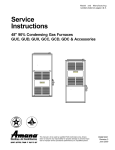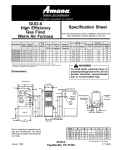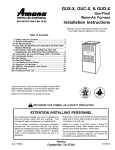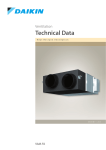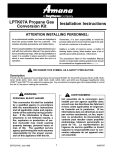Download Amana VR8205 Instruction manual
Transcript
® Heating ¡ Air Conditioning A higher standard of comfort HANG09 &10, HALP08, and HAPS17-26 Installation Instructions High Altitude Conversion Kit Affix this manual, Specification Sheet and Users Information Manual adjacent to the furnace. Description WARNING This conversion kit shall be installed by a qualified agency in accordance with the manufacturer’s instructions and all applicable codes and requirements of the authority having jurisdiction. If the information in these instructions is not followed exactly, a fire, explosion or production of carbon monoxide may result causing property damage, personal injury or loss of life. The qualified service agency performing this work assumes responsibility for the proper conversion of this appliance with this kit. When the Amana GUC, GDC, GUD, GCD, or GUX furnace is installed at altitudes above 4000 feet, the fuel input of the furnace must be reduced. This derating of the appliance must be followed since as the altitude increases, the CFM moved by the induced draft and blower fans remain almost constant while the pounds of oxygen in that air is reduced. If this procedure is not followed and the fuel input is not reduced, combustion can be inefficient, incomplete or can possibly result in premature failure of the heat exchanger due to an excessive temperature rise. The orifices in the high altitude kits have been selected as a result of testing with the American Gas Association. They will provide appropriate derating at altitudes above rated altitudes shown in Table 1. The selection is based on nonderated gas (about 1000 BTU/Ft 3 for natural gas, and 2500 BTU/Ft 3 for propane gas). If your gas supply has been derated for the altitude, contact your gas supplier for orifice sizing. THE INSTALLATION AND SERVICING OF THIS EQUIPMENT SHOULD BE PERFORMED ONLY BY QUALIFIED, EXPERIENCED TECHNICIANS. IN CANADA “THE CONVERSION SHALL BE CARRIED OUT IN ACCORDANCE WITH THE REQUIREMENTS OF THE PROVINCIAL AUTHORITIES HAVING JURISDICTION AND IN ACCORDANCE WITH THE REQUIREMENTS OF THE CAN/CGS B149.1 AND B149.2 INSTALLATION CODE.” THIS KIT IS NOT INTENDED FOR USE IN CANADA. THE AMANA 90% FURNACES ARE CGA CERTIFIED TO 4500 FEET ONLY. ! RECOGNIZE THIS SYMBOL AS A SAFETY PRECAUTION. ATTENTION INSTALLING PERSONNEL As a professional installer you have an obligation to know the product better than the customer. This includes all safety precautions and related items. Prior to actual installation, thoroughly familiarize yourself with this Instruction Manual. Pay special attention to all safety warnings. Often during installation or repair it is possible to place yourself in a position which is more hazardous than when the unit is in operation. safely and to know it well enough to be able to instruct a customer in its safe use. Safety is a matter of common sense...a matter of thinking before acting. Most dealers have a list of specific good safety practices...follow them. The precautions listed in this Installation Manual should not supersede existing practices but should be considered as supplemental information. Remember, it is your responsibility to install the product August 1998 (1) Amana Fayetteville, TN 37334 10314616 WARNING If the information in these instructions is not followed exactly, a fire or explosion may result causing property damage, personal injury or loss of life. —Do not store or use gasoline or other flammable vapors and liquids in the vicinity of this or any other appliance. —What to do if you smell gas: • Do not try to light any appliance. • Do not touch any electrical switch; do not use any phone in your building. • Immediately call your gas supplier from a neighbor’s phone. Follow the gas supplier’s instructions. • If you cannot reach your gas supplier, call the fire department. —Installation and service must be performed by a qualified installer, service agency or the gas supplier. Tridelta Style 1 MPL Figure 1 Pressure Switch (GDC) Tridelta Style 1 Tridelta Style 2 MPL Figure 2 Pressure Switches (GUD, GCD) 3. Remove pressure switch. (Requires removing two mounting screws, disconnecting rubber hose(s) and disconnecting wiring.) (Figures 1 & 2) GDC Furnaces: One switch requires changing. The pressure switch connected to the induced draft blower requires removal. The “coil cover” pressure switch does not require changing. 4. Install the pressure switch provided in the kit. See Table 1 for the appropriate kit needed. GUC and GUX Furnaces: If installing an MPL pressure switch on a GUC or GUX furnace, the pressure switch bracket must be relocated to allow proper orientation of the pressure tap. To relocate bracket, remove the two screws securing the bracket to the switch. Place the bracket on the tap side of the switch with the bracket mounting flange parallel with the pressure tap. The mounting flange should also be pointing away from the switch. See figure 3 below for GUC and GUX pressure switches. Do not derate by adjusting the manifold pressure to a lower pressure reading than what is specified on the furnace nameplate. With a lower density of air and a lower manifold pressure at the burner orifice, the orifice will not aspirate the proper amount of air into the burner. This can cause incomplete combustion of the gas, flashback, and possible yellow tipping. In addition to using smaller orifices to reduce the fuel input, a different pressure switch must be used at altitudes above 4000 feet because of the reduced air density. This is required regardless of the heat content of the fuel used. Pressure Switch Installation 1. Shut off gas and disconnect power supply to furnace. WARNING To avoid death or personal injury due to electrical shock, disconnect the electrical supply to the furnace before installing this kit or performing any service. Tridelta Style 1 2. Remove high voltage box cover (GUC and GUX only). Tridelta Style 2 MPL Figure 3 Pressure Switches (GUC, GUX) CAUTION To avoid personal injury or property damage due to fire, make certain all wires disconnected from the pressure switch during this procedure are properly reconnected. 5. Reconnect the hose(s). Reconnect all wires. Verify wiring on the wiring diagram located inside the blower compartment access panel. 6. Reinstall high voltage cover (GUC and GUX only). 2 HAPS26 HAPS25 HAPS24 HAPS23 HAPS22 HAPS21 HAPS20 X HAPS19 17 ± 2% 28 ± 2% HAPS18 HAPS17 Pressure Switch Kits Natural Gas Derates GUC045 4001 - 7000 ft 7001 - 10000 ft X GUC070, GDC045 4001 - 7000 ft 7001 - 10000 ft 17 ± 2% 28 ± 2% X X GUC090 4001 - 7000 ft 7001 - 10000 ft 17 ± 2% 28 ± 2% X X GUC115, GDC070, GDC115 4001 - 7000 ft 7001 - 10000 ft 17 ± 2% 28 ± 2% X X GUX045 4001 - 7000 ft 7001 - 10000 ft 17 ± 2% 28 ± 2% X X GUX070 4001 - 7000 ft 7001 - 10000 ft 17 ± 2% 28 ± 2% X 17 ± 2% 28 ± 2% X 17 ± 2% 28 ± 2% X X GUX090, GDC090 4001 - 7000 ft 7001 - 10000 ft X GUX115 4001 - 7000 ft 7001 - 10000 ft X GUD045 4001 - 7000 ft 7001 - 10000 ft 17 ± 2% 28 ± 2% X 17 ± 2% 28 ± 2% X X GUD070 4001 - 7000 ft 7001 - 10000 ft X GUD090 4001 - 7000 ft 7001 - 10000 ft 17 ± 2% 28 ± 2% X X GUD115 4001 - 7000 ft 7001 - 10000 ft 17 ± 2% 28 ± 2% X X GCD070 4001 - 7000 ft 7001 - 10000 ft 17 ± 2% 28 ± 2% X X GCD090 4001 - 7000 ft 7001 - 10000 ft Pressure Switch Setting ( Inches W.C.) 17 ± 2% 28 ± 2% X X -1.20 -1.05 -1.20 -1.30 -0.75 -0.90 -1.05 -0.70 -0.80 -0.97 NOTE: These kits are not intended for use in Canada. The Amana 90% furnaces are CGA certified to 4500 feet only. Table 1 3 Orifice Installation Remove two screws on each side of burner box Figure 3 Orifices 1. Turn off the gas supply 2. Remove the front cover from the air box surrounding the burners. (GUD and GCD Only) 3. Disconnect the low voltage wires from the gas valve. 4. Remove the four screws attaching the manifold to the air box. Figure 5 GUD and GCD Burner Box 5. Pull manifold straight out of air box. Replace natural gas orifices with the correct orifice kit depending upon propane or natural gas usage and the altitude at the installation site. Refer to Tables 2 and 3 for the appropriate kit required. 6. Tighten orifices with a box-end wrench. To prevent damage to the orifices do not use a socket wrench, overtighten, or cross-thread. 7. Replace manifold and low voltage wires. Make certain that no wires will contact any hot surfaces or obstruct gas flow from orifices. 8. If converting to propane, see PROPANE CONVERSION for additional instructions. If remaining on natural gas, skip to OPERATIONAL CHECK. Remove two screws on each side of burner box Figure 4 GUC, GDC, and GUX Burner Box Altitude As Shipped HANG09 HANG10 Total Derate Total Derate Range (%/1000 ft) (Feet) #43 #44 #45 Range (%) 0 - 4000 X 0.0 to 9.1 down to 2.27 4001 - 7000 X 14.7 to 19.0 3.7 to 2.7 7001 - 10000 X 26.1 to 29.8 3.7 to 3.0 Table 2 Natural Gas Orifice Altitude (Feet) LPTK09 #55 0 - 4500 4501 - 9500 X HALP08 #56 X Table 3 Propane Gas Orifice 4 Propane Conversion 5. Attach conversion data plate, with correct input rating, adjacent to the unit rating plate. 6. Post “conversion date certificate” adjacent to the furnace. WARNING To prevent death, serious personal injury or property damage due to fire or explosion caused by a propane gas leak, install a gas detecting warning device. If the propane gas furnace is installed in a basement, an excavated area or a confined space, a warning device is required due to: • Propane gas is heavier than air and any leaking gas can settle in any low areas or confined spaces. • Propane gas odorant may fade, making the gas undetectable except with a warning device. If the presence of gas is suspected, follow the instructions on Page 2 of this manual. Gas Valve On/Off Control Knob INLET OUTLET Pressure Regulator Adjustment (Under Cap Screw) Inlet Pressure Tap (Side of Valve) Outlet (Manifold) Pressure Tap Figure 6 White-Rodgers Models 36E36 or 36E37 Gas Valves WARNING Pressure Regulator Adjustment (Under Cap Screw) To prevent death, personal injury or property damage due to fire or explosion caused by a propane gas leak, install a gas detecting warning device. Since rust can reduce the level of odorant in propane gas, a gas detecting warning device is the only reliable way to detect a propane gas leak. Contact a local propane gas supplier about installing a gas detecting warning device. Outlet (Manifold) Pressure Tap Honeywell INLET OUTLET ON OFF Inlet Pressure Tap IMPORTANT NOTE: To prevent unsatisfactory furnace operation, the proper gas conversion kit must be used for each gas valve. Use the White-Rodgers spring kit only with the White-Rodgers gas valve: use the Honeywell spring kit only with the Honeywell gas valve. The spring kits are not interchangeable. Gas Valve On/Off Control Knob Figure 7 Honeywell Model VR8205 Gas Valve Gas Valve On/Off Selector Switch Important: Propane gas is heavier than air and does not vent upward as with natural gas fuels. 1. Replace the gas valve regulator spring with the spring included in the propane conversion kit. If the unit is equipped with a White-Rodgers 36E gas valve (Figures 6 and 8) use Spring Kit #92-0659. If the unit is equipped with a Honeywell VR8205 gas valve (Figure 7), use Spring Kit #393691. In either case, change the regulator spring per instructions included with the particular regulator spring kit. Discard whichever spring kit is not used. 2. Attach label from spring kit to gas valve indicating propane conversion. 3. Attach conversion data plate, with correct input rating adjacent to the unit rating plate. 4. Attach the label (found in the spring kit) to the gas valve, indicating propane conversion. INLET O F F M 1 P 3 C 2 OUTLET ON Pressure Regulator Inlet Pressure Tap Adjustment (Side of Valve) (Under Cap Screw) Outlet (Manifold) Pressure Tap (Side of Valve) Figure 8 White-Rodgers Models 36E22 or 36E23 Gas Valves 5 Operational Check TO BURNER BOX TO VENT BLOWER 1. Start the furnace using the procedures in the section, “Operating Your Furnace” in the installation instructions. In addition, perform the following checks and adjustments. 2. Check for leaks by using a soap solution when the furnace is initially operated. TO VENT BLOWER TO BURNER BOX TRIDELTA TRIDELTA (METAL & PLASTIC BODY) (ALL METAL BODY) (ROTATED 90 FOR CLARITY) WARNING To prevent death, personal injury or property damage due to fire or explosion, do not use a flame to check for leaks. MPL Following the leak check, replace the air box cover (GUD and GCD). 3. Check gas input and pressures. Gas supply pressure with the burners operating must be as specified on the rating plate. 4. Check the manifold pressure. A tapped opening (“Manifold Pressure Tap” in Figures 6, 7, or 8) is provided in the gas valve to facilitate measurement of the manifold pressure. A “U Tube” manometer having a scale range from 0 to 12 inches of water should be used for this measurement. The manifold pressure must be measured with the burners operating. For direct vent furnaces see Figure 9 for “U Tube” manometer connections. See Figure 10 for direct vent furnace pressure switch connections. Figure 10 Pressure Switch Connections for Direct Vent Furnaces To adjust the pressure regulator, remove the adjustment screw cover on the gas valve. Turn out (counterclockwise) to decrease pressure, turn in (clockwise) to increase pressure. (“Manifold Pressure Adjustment” in Figures 6, 7, or 8). Only small variations in gas flow should be made by means of the pressure regulator adjustment. In no case should the final manifold pressure vary more than plus or minus 0.3 inches water column from the pressure specified (10.0 inches w.c. for propane, see furnace nameplate for natural gas manifold pressure). Adjustment screw cover must be in place when furnace is operating. Any major changes in flow must be made by changing the size of the burner orifices. 5. Check gas input (natural gas only). To measure the gas input using the gas meter proceed as follows: a. Turn off gas supply to all other appliances except the furnace. b. With the furnace operating, time the smallest dial on the meter for one complete revolution. If this is a 2 cubic foot dial, divide the seconds by 2; if it is a 1 cubic foot dial, use the seconds as is. This gives the seconds per cubic foot of gas being delivered to the furnace. c. INPUT = GAS HTG VALUE x 3600 ÷ SECONDS PER CUBIC FOOT Example: Natural gas with a heating value of 1000 BTU per cubic foot and 34 seconds per cubic foot as determined by Step b., then: Input = 1000 x 3600 ÷ 34 = 106,000 BTU per Hour NOTE: BTU content of the gas should be obtained from the gas supplier. NOTE: 3600 is a conversion factor between seconds and hours. GAS VALVE A C TO VENT BLOWER TO BURNER BOX BURNER BOX B PRESSURE SWITCH D D VENT BLOWER U-TUBE MANOMETER A - CAP OVER ADJUSTMENT SCREW MUST BE IN PLACE WHEN FURNACE IS OPERATING. B - SEE PRESSURE SWITCH DIAGRAM FOR PRESSURE SWITCH HOSE CONNECTIONS. TO MEASURE MANIFOLD PRESSURE CONNECT MANOMETER BETWEEN C AND D. C - HOSE BETWEEN GAS VALVE AND AIR BOX (TEE TO BE SUPPLIED BY SERVICER.) D - TAPPED OPENING IN MANIFOLD (HOSE BARB TO BE SUPPLIED BY SERVICER.) Figure 9 Direct Vent Manometer Connections 6 temperature rise will be approximately the same. Temperature rise must still be within the limits shown on the unit nameplate. Check the temperature rise through the unit by placing thermometers in supply and return air registers as close to the furnace as possible. Thermometers must not be able to “see” the furnace’s heat exchangers, or false readings could be obtained. All registers must be open; all duct dampers must be in their final (fully or partially open) position, and the unit operated for 15 minutes before taking readings. The temperature rise must be within the range specified on the rating plate. NOTE: If air temperature rise is not obtained, it may be necessary to change the blower speed. A higher blower speed will reduce the temperature rise. A slower blower speed will increase the temperature rise. Derating Example 1: GUC115X50B at 8500 ft. Sea level input = 115,000 BTU/Hr From Table 1: Derate at 8,500 ft. = 28±2% Since we are at the mid point of the elevation range, we use the mid point of the derate; 28%. New Input = 115,000 x (1 - .28) = 82,800 BTU/Hr Derating Example 2: GUD115X50B at 4001 ft. Sea level input = 115,000 BTU/Hr From Table 1: Derate at 7500 ft. = 17±2% Since we are at the lower end of the elevation range, we use the lower derate; (17 - 2) = 15% New Input = 115,000 x (1 - .15) = 97,750 BTU/Hr d. Relight all other appliances turned off in Step a. Be sure all pilot burners are operating. 6. Check the gas input - Propane Gas Verify the gas input rate by checking that the appropriate orifices have been installed and the manifold pressure has been set as stated in these instructions. 7. Check burner flame. Flames should be stable, soft and blue, (dust may cause orange tips but they must not be yellow). They should extend directly outward from the burners without curling, floating or lifting off. See Figure 10 for GUC and GUX. For the GUD and GCD, the flames can be inspected through the observation window on the front cover. If it is necessary to adjust the blower speed, consult the furnace installation manual for details. Complete The Installation See the furnace installation manual for all installation details which were not covered in this booklet. Due to policy of continual product improvement, the right is reserved to change specifications and design without notice. Amana, 1810 Wilson Parkway, Fayetteville TN 37334 Check the burner flames for: 1. Good adjustment 2. Stable, soft and blue 3. Not curling, floating, or lifting off. Figure 10 Burner Flame (GUC and GUX) 8. Check the normal operating sequence of the ignition system to insure burners light properly. 9. Check Temperature Rise. NOTE: The relationship between ESP and temperature rise will be different than is shown in the Installation Instructions, while the relationship between CFM and 7







